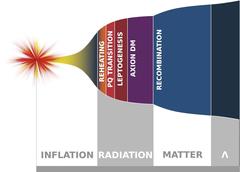URL: https://www.desy.de/news/news_search/index_eng.html
Breadcrumb Navigation
DESY News: Solving five big questions in particle physics in a SMASH
News
News from the DESY research centre
Solving five big questions in particle physics in a SMASH
The extremely successful standard model of particle physics has an unfortunate limitation: the current version is only able to explain about 15 percent of the matter found in the universe. Although it describes and categorises all the known fundamental particles and interactions, it does so only for the type of matter we are familiar with. However, astrophysical observations suggest that the mysterious dark matter is more than five times as common. An international team of theoretical physicists has now come up with an extension to the standard model which could not only explain dark matter but at the same time solve five major problems faced by particle physics at one stroke. Guillermo Ballesteros, from the University of Paris-Saclay, and his colleagues are presenting their SMASH model (“Standard Model Axion Seesaw Higgs portal inflation” model) in the journal Physical Review Letters.

The history of the universe according to SMASH, denoting the different phases and the dominant energies of the epochs since the Big Bang. Credit: DESY
Using these extensions, the scientists were able to solve five problems: the axion is a candidate for dark matter, which astrophysical observations suggest is five times more ubiquitous than the matter we are familiar with, which is described by the standard model. The heavy neutrinos explain the mass of the already known, very light neutrinos; and the rho interacts with the Higgs boson to produce so-called cosmic inflation, a period during which the entire young universe suddenly expanded by a factor of at least one hundred septillion for hitherto unknown reasons. In addition, SMASH provides explanations as to why our universe contains so much more matter than antimatter, even though equal amounts must have been created during the big bang, and it reveals why no violation of so-called CP symmetry is observed in the strong force, one of the fundamental interactions.

The particles of the standard model (SM, left) and of the extension SMASH (right). Credit: Carlos Tamarit, University of Durham
Being able to calculate these values with such precision means that SMASH could potentially be tested experimentally within the next ten years. “The good thing about SMASH is that the theory is falsifiable. For example, it contains very precise predictions of certain features of the so-called cosmic microwave background. Future experiments that measure this radiation with even greater precision could therefore soon rule out SMASH – or else confirm its predictions,” explains Ringwald. A further test of the model is the search for axions. Here too, the model is able to make accurate predictions, and if axions do indeed account for the bulk of dark matter in the universe, then SMASH requires them to have a mass of 50 to 200 micro-electronvolts, in the units conventionally used in particle physics. Experiments that examine dark matter more precisely could soon test this prediction too.
Javier Redondo from the University of Saragossa in Spain and Carlos Tamarit from the University of Durham in England were also involved in the study.
Reference:
Unifying inflation with the axion, dark matter, baryogenesis and the seesaw mechanism; Guillermo Ballesteros, Javier Redondo, Andreas Ringwald, Carlos Tamarit; Physical Review Letters, 2017; DOI: 10.1103/PhysRevLett.118.071802
Read the APS synopsis: http://physics.aps.org/synopsis-for/10.1103/PhysRevLett.118.071802




